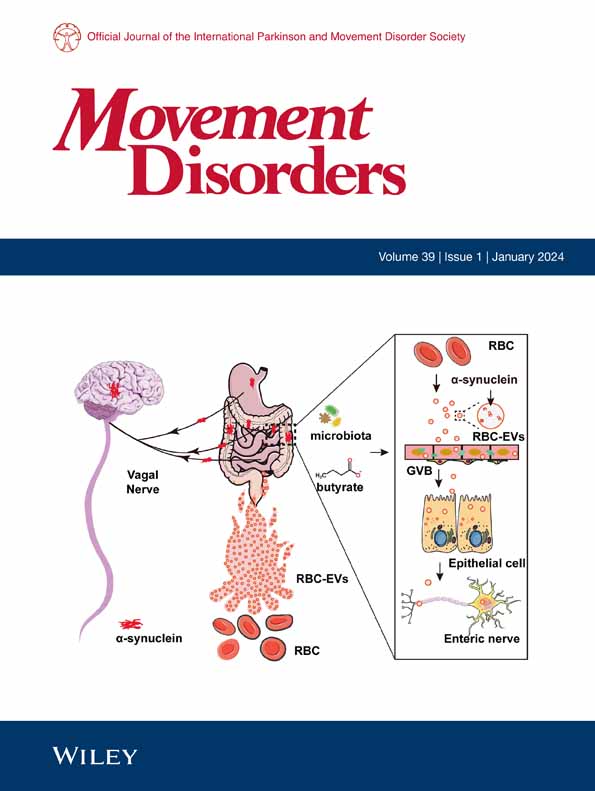Decreased Peripheral Blood Lymphocytes in Spinocerebellar Ataxia Type 3 Correlate with Disease Severity
IF 7.4
1区 医学
Q1 CLINICAL NEUROLOGY
Qi Deng, Cuiling Tang, Zhao Chen, Xinrong Yuan, Ziyan Ding, Chunrong Wang, Linlin Wan, Jian Hu, Feiyan Deng, Zhe Long, Lang He, Linliu Peng, Lijing Lei, Hongyu Yuan, Na Wan, Yiqing Gong, Yan Tan, Siyu Ding, Beisha Tang, Rong Qiu, Hong Jiang
求助PDF
{"title":"Decreased Peripheral Blood Lymphocytes in Spinocerebellar Ataxia Type 3 Correlate with Disease Severity","authors":"Qi Deng, Cuiling Tang, Zhao Chen, Xinrong Yuan, Ziyan Ding, Chunrong Wang, Linlin Wan, Jian Hu, Feiyan Deng, Zhe Long, Lang He, Linliu Peng, Lijing Lei, Hongyu Yuan, Na Wan, Yiqing Gong, Yan Tan, Siyu Ding, Beisha Tang, Rong Qiu, Hong Jiang","doi":"10.1002/mds.30189","DOIUrl":null,"url":null,"abstract":"BackgroundThe immune system likely plays a role in the pathogenesis of spinocerebellar ataxia type 3 (SCA3). Peripheral blood leukocytes are indicative of the immune status in neurodegenerative diseases. However, alterations in the characteristics of peripheral blood leukocytes at different stages of SCA3 and their potential roles in disease progression remain unclear.ObjectivesThe goal was to identify leukocyte profiles alterations at different stages of SCA3 and analyze their correlation with disease severity.MethodsThis cross‐sectional study included 150 total <jats:italic>ATXN3</jats:italic> expansion carriers (20 pre‐ataxic and 130 ataxic) and 113 healthy controls. Differences in leukocyte profiles were analyzed, and correlations with clinical characteristics were assessed using Spearman and partial correlation. Logistic regression and receiver operating characteristic curve identified independent factors associated with disease severity. Mediation analysis evaluated the effect of lymphocyte counts on the relationship between disease duration and SARA scores.ResultsAlterations in neutrophil, lymphocyte, eosinophil, and basophil counts were observed across <jats:italic>ATXN3</jats:italic> expansion carriers, including those in pre‐ataxic and ataxic stages, compared with healthy controls. Lymphocyte counts negatively correlated with SARA and International Cooperative Ataxia Rating Scale scores, particularly in speech function. Leukocyte, monocyte, and basophil counts were also negatively associated with ataxia scales scores or sub‐item scores. Lymphocyte counts distinguished disease severities, and partially mediated the effect of disease duration on ataxia scale scores in ataxic SCA3.ConclusionsLeukocyte profiles alterations at different stages of SCA3 may be closely linked to disease progression and severity. Lymphocyte counts may serve as valuable indicators of disease severity. © 2025 International Parkinson and Movement Disorder Society.","PeriodicalId":213,"journal":{"name":"Movement Disorders","volume":"26 1","pages":""},"PeriodicalIF":7.4000,"publicationDate":"2025-04-10","publicationTypes":"Journal Article","fieldsOfStudy":null,"isOpenAccess":false,"openAccessPdf":"","citationCount":"0","resultStr":null,"platform":"Semanticscholar","paperid":null,"PeriodicalName":"Movement Disorders","FirstCategoryId":"3","ListUrlMain":"https://doi.org/10.1002/mds.30189","RegionNum":1,"RegionCategory":"医学","ArticlePicture":[],"TitleCN":null,"AbstractTextCN":null,"PMCID":null,"EPubDate":"","PubModel":"","JCR":"Q1","JCRName":"CLINICAL NEUROLOGY","Score":null,"Total":0}
引用次数: 0
引用
批量引用
Abstract
BackgroundThe immune system likely plays a role in the pathogenesis of spinocerebellar ataxia type 3 (SCA3). Peripheral blood leukocytes are indicative of the immune status in neurodegenerative diseases. However, alterations in the characteristics of peripheral blood leukocytes at different stages of SCA3 and their potential roles in disease progression remain unclear.ObjectivesThe goal was to identify leukocyte profiles alterations at different stages of SCA3 and analyze their correlation with disease severity.MethodsThis cross‐sectional study included 150 total ATXN3 expansion carriers (20 pre‐ataxic and 130 ataxic) and 113 healthy controls. Differences in leukocyte profiles were analyzed, and correlations with clinical characteristics were assessed using Spearman and partial correlation. Logistic regression and receiver operating characteristic curve identified independent factors associated with disease severity. Mediation analysis evaluated the effect of lymphocyte counts on the relationship between disease duration and SARA scores.ResultsAlterations in neutrophil, lymphocyte, eosinophil, and basophil counts were observed across ATXN3 expansion carriers, including those in pre‐ataxic and ataxic stages, compared with healthy controls. Lymphocyte counts negatively correlated with SARA and International Cooperative Ataxia Rating Scale scores, particularly in speech function. Leukocyte, monocyte, and basophil counts were also negatively associated with ataxia scales scores or sub‐item scores. Lymphocyte counts distinguished disease severities, and partially mediated the effect of disease duration on ataxia scale scores in ataxic SCA3.ConclusionsLeukocyte profiles alterations at different stages of SCA3 may be closely linked to disease progression and severity. Lymphocyte counts may serve as valuable indicators of disease severity. © 2025 International Parkinson and Movement Disorder Society.
背景免疫系统很可能在脊髓小脑共济失调 3 型(SCA3)的发病机制中发挥作用。外周血白细胞是神经退行性疾病免疫状态的指标。方法这项横断面研究共纳入 150 名 ATXN3 扩增携带者(20 名共济失调前期患者和 130 名共济失调患者)和 113 名健康对照者。研究人员分析了白细胞特征的差异,并使用斯皮尔曼相关和部分相关方法评估了白细胞特征与临床特征的相关性。逻辑回归和接收器操作特征曲线确定了与疾病严重程度相关的独立因素。结果与健康对照组相比,ATXN3扩增携带者(包括共济失调前期和共济失调期携带者)的中性粒细胞、淋巴细胞、嗜酸性粒细胞和嗜碱性粒细胞计数发生了改变。淋巴细胞计数与 SARA 和国际合作共济失调评分量表(International Cooperative Ataxia Rating Scale)的评分呈负相关,尤其是在语言功能方面。白细胞、单核细胞和嗜碱性粒细胞计数也与共济失调量表评分或分项评分呈负相关。在共济失调型 SCA3 患者中,淋巴细胞计数可区分疾病的严重程度,并部分调节疾病持续时间对共济失调量表评分的影响。淋巴细胞计数可作为疾病严重程度的重要指标。© 2025 国际帕金森和运动障碍协会。
本文章由计算机程序翻译,如有差异,请以英文原文为准。
来源期刊
期刊介绍:
Movement Disorders publishes a variety of content types including Reviews, Viewpoints, Full Length Articles, Historical Reports, Brief Reports, and Letters. The journal considers original manuscripts on topics related to the diagnosis, therapeutics, pharmacology, biochemistry, physiology, etiology, genetics, and epidemiology of movement disorders. Appropriate topics include Parkinsonism, Chorea, Tremors, Dystonia, Myoclonus, Tics, Tardive Dyskinesia, Spasticity, and Ataxia.

 求助内容:
求助内容: 应助结果提醒方式:
应助结果提醒方式:


